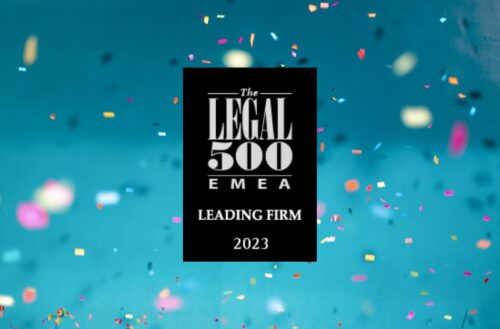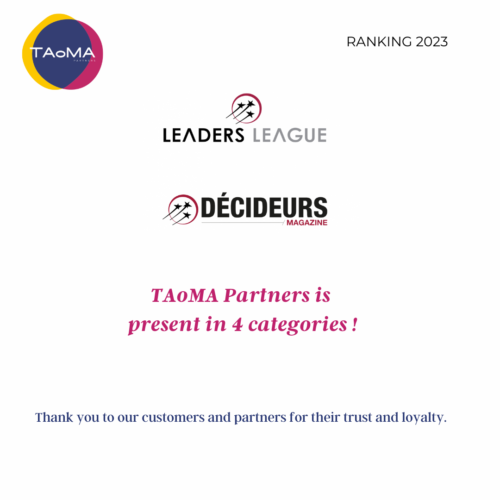14
May
2024
Pioneering the future: the European Union’s regulatory framework for Artificial Intelligence
As early as October 20201, the European Council set forth an ambitious objective for the EU to become a “leading global player in the development of safe, reliable, and ethical artificial intelligence”.
On April 21, 2021, the European Commission unveiled its draft regulatory, the AI Act, establishing a set of harmonized rules on AI which was adopted by the European Council at the end of 2022.
Following the legislative journey, a provisional agreement was reached between the European Parliament and the Council on December 9, 2023, culminating in three days of intense negotiations.
This legislation was ultimately embraced on Wednesday, March 13, 2024, by a sweeping majority of the European deputies.
But what are the key contributions of this text?
Balancing technology neutrality with asymmetric regulation
The AI Act puts forward a broad definition to encompass all AI systems, aiming to prevent becoming outdated amid technological progress. It defines AI as “software that is developed with one or more of the techniques and approaches listed in Annex I and can, for a given set of human-defined objectives, generate outputs such as content, predictions, recommendations, or decisions influencing the environments they interact with.2”
While the text aims to be applicable to a broad spectrum of AI systems, it introduces an asymmetric field of application, moderating its claimed technological neutrality.
The legislation adopts a risk-based approach: risks are classified into three levels, from unacceptable to minimal, each associated with a specific legal regime.
Low-risk AI systems are only subject to light regulation3, while “high-risk” AI applications and systems categorized as presenting “unacceptable risks” are more heavily impacted.
High-risk AI systems under regulation
High-risk AI systems are those posing significant risks to health, safety, or fundamental rights of individuals. The AI Act dedicates its Title III to these systems.
Initially, high-risk AI is defined as systems designed to be used as a safety component or constituting such a product, subject to an ex-ante conformity assessment by a third party.
Additionally, Annex III lists limited high-risk AI systems, which the European Commission can update to stay abreast of technological advancements4.
These AI systems are, in principle, permitted in the European market, provided they comply with regulations set out in Chapter 2 of Title III. These requirements cover various aspects such as risk management systems, data governance, documentation and record-keeping, transparency, user information, human oversight, robustness, and (cyber)security of systems.
These obligations are primarily directed at AI system providers. However, users, manufacturers, or other parties are also subject to obligations outlined in Title III.
Unacceptable risk AIs are (in principle) prohibited.
Title II lists prohibited practices concerning AI systems whose use is deemed unacceptable because they contravene the Union’s values, especially due to potential violations of fundamental rights.
For example, prohibited are5:
• ” the placing on the market, putting into service or use of an AI system that deploys subliminal techniques beyond a person’s consciousness in order to materially distort a person’s behaviour in a manner that causes or is likely to cause that person or another person physical or psychological harm; (…).”
• “the placing on the market, putting into service or use of AI systems by public authorities or on their behalf for the evaluation or classification of the trustworthiness of natural persons over a certain period of time based on their social behaviour or known or predicted personal or personality characteristics, with the social score leading to either or both of the following(…).”
An exception exists for real-time remote biometric identification systems in publicly accessible spaces, listed among prohibited practices, which can be authorized for law enforcement purposes, subject to necessity and proportionality conditions.
AI systems with specific manipulation risks are governed by a special regulatory framework
This specific regime applies to certain AI systems, particularly those intended to interact with natural persons or to generate content. This regime applies beyond the risk classification, meaning even low-risk AI systems may be subject to this transparency regime.
These systems will be subject to specific transparency obligations6.
For instance, additional obligations include informing individuals that they are interacting with an AI system or exposed to an emotion recognition system. The regulation also addresses “deep fakes7“, where it is mandatory, except for exceptions, to disclose that content is generated by automated means.
Conclusion
The AI Act is a comprehensive text attempting to regulate artificial intelligence systems, aiming to mitigate the associated risks and foster a trustworthy technology ecosystem.
It’s crucial to highlight that the intent is not to impose heavy regulations on businesses or individuals initiating AI systems. Rather, the goal is to limit the requirements to “the minimum necessary” to address AI risks without unduly restricting technological development or disproportionately increasing the cost of bringing AI solutions to market8.
This rationale is why the text reduces regulatory burdens on SMEs and startups and establishes regulatory sandboxes providing a controlled environment to facilitate the development, testing, and validation of AI systems9.
Now awaiting formal adoption by the Council! The legislation will come into effect 20 days after its publication in the Official Journal and will be fully applicable 24 months later, with some provisions coming into force sooner or later.
Let’s not forget, AI is rapidly evolving and is still in its infancy! Daily applications are as plentiful as the potential risks they may pose. In this context, the EU innovates by seeking to mitigate these risks without hindering the development of artificial intelligence.
The TAoMA Team remains at your disposal for any inquiries on this subject!
Juliette Danjean
Trainee lawyer
Jean-Charles Nicollet
European Trademark & Design Attorney – Partner
(1) Extraordinary meeting of the European Council on the 1st and 2nd of October, 2020.
(2) See article 5, Title II of the Regulation’s latest iteration.
(3) See Title IX’s singular article that encourages AI system providers to maintain codes of conduct. This initiative seeks to inspire providers of AI systems, which are not deemed high-risk, to voluntarily adopt standards designated for high-risk systems as outlined in Title III.
(4) The text currently lists specific high-risk AI systems, such as those used for biometric identification and the classification of individuals, along with systems managing critical infrastructure operations (including traffic, water, gas, heating, and electricity supply).
(5) See article 5, Title II of the Regulation’s latest iteration.
(6) See Title IV of the Regulation’s latest version.
(7) The European Parliament defines “deep fakes” as the result of AI-driven media manipulation, described as hyper realistic alterations to reality. (Accessible at: https://multimedia.europarl.europa.eu/fr/audio/deepfake-it_EPBL2102202201_EN)
(8) Recitals of the European Commission’s Proposed Regulation (1; 1.1)
(9) See Title V of the Regulation’s latest version.
13
April
2023
LEGAL500 EMEA 2023: TAoMA Partners awarded again
The Legal500 EMEA 2023 ranking once again honors our teams by ranking TAoMA among the best Patent and Trademark Attorneys in France!
The Legal500 describes TAoMA as a firm that “supports its clients in IP portfolio management, working in France and the EU to assist with transactional and litigious matters, conducting filings, renewals, registrations and opposition proceedings to defend clients’ IP globally”.
We would like to thank in particular our clients and partners who recommended our firm.
One of the things they said about us was “What makes the difference at TAoMA is the level of its team, which has a very strong entrepreneurial spirit. Each member has the same vision and values which means that from one person to another, we find the same qualities of listening and desire to provide all possible help”.
Congratulations to our entire team for this great recognition!
17
March
2023
TAoMA Partners is once again present in the Deciders/LeadersLeague 2023 ranking !
TAoMA Partners is proud to be present again this year in The Deciders/Leaders League 2023 ranking ! Our teams are honored in 4 catégories :
«EXCELLENT»
Marketing, communication & Digital – Trademarks, designs & models – Intellectual property Attorneys
«HIGHLY RECOMMENDED»
Industrial Property – Management of trademark, design and model portfolios – Law firm
Industrial property – Trademarks: litigation – Law firm
«RECOMMENDED»
Innovation, Technologies & Telecoms – Data protection law – Law firm
Thank you to our customers and partners for their trust and loyalty.
Congratulations to our team, without whom nothing would be possible!
Find the ranking here
05
December
2022
NFT’s battle: 1-0 for Juventus!
There is no need to introduce Juventus anymore, even for those who don’t know anything about soccer!
If Juve, for the intimate, fights every day on the soccer fields, it is not left behind when it comes to defending its rights in court, and with some success.
In one of the first decisions in the European Union in this area, Juve won outright against digital playing cards authenticated by NFT.
Short summary of the competition
In 2021, Blockeras s.r.l. has obtained the agreement of various active and retired footballers to launch the Coin Of Champion project, which consists of the production of playing cards bearing their likeness and authenticated by NFT.
One of the cards represented the former center forward Bobo VIERI wearing his old Juve jersey.
In 2022, Blockeras launches the marketing of its cards driving the Juventus attack.
Indeed, the latter is the owner of numerous trademarks including the word marks JUVE, JUVENTUS and a figurative mark representing its famous jersey with black and white stripes bearing 2 stars.
Juve discovered the production (mintage), advertising and sale of the cards authenticated by NFT containing its trademarks without its authorization, so it brought an action before the Court of First Instance of Rome in the context of a “preliminary injunction”. It considers that these cards constitute acts of infringement of its trademarks and unfair competition.
In its defense, Blockeras argues, among other things, that the trademarks invoked were not registered for downloadable virtual goods!
Scoreboard
The Court of First Instance of Rome notes that the trademarks concern the most successful Italian soccer team that has won the most competitions.
In addition, Juve has a widespread merchandising activity in different sectors (clothing, games, etc.) both on the web and in physical stores in different Italian cities.
Thus, the use of the image of Bobo VIERI, wearing his Juve jersey, entails a use of trademarks without authorization from Juventus. This is purely commercial purposes and the authorization of Bobo VIERI to use his image wearing his Juve jersey should also have been requested from the famous soccer club since the reputation of its trademarks contributes to the value of the digital card authenticated by NFT.
As for Blockeras’ argument that the marks are not protected in class 9 for virtual goods, the court dismisses it out of hand. In fact, it noted that the marks designate different products, notably in class 9, which are related to “downloadable electronic publications”.
In addition, it states that Juve is active in the world of crypto games, crypto currencies and NFTs especially through agreements with the French company Sorare.
It therefore concludes that the creation and marketing of the digital cards by Blockeras infringes Juve’s trademarks.
Comment (non-sporting)
Last June, the European Intellectual Property Office (EUIPO) published its “guidelines” for NFTs in which it considers that they fall under class 9 “because they are treated as digital content or images”. This raises a presumption that trademarks for physical goods must also be registered for virtual goods if their owners wish to be protected for the latter.
This decision of the Court of First Instance of Rome also seems to point in this direction since it recognizes the similarity between the virtual cards authenticated by NFT with the “downloadable electronic publications” to which products designated by the Juventus trademarks are linked. It is true that the court also considers the marked activity of Juve in the field of crypto games and crypto currencies to reinforce the risk of confusion in the public mind.
Nevertheless, if Juve’s trademarks had not designated products related to downloadable electronic publications, we can wonder if the court would have had the same reasoning despite the soccer club’s activity in these new technologies.
Given the current uncertainties related to NFTs, it is therefore strongly recommended to extend the protection of one’s trademarks to virtual products, at least as a precaution.
Please feel free to contact us to discuss and set up a branding strategy adapted to your needs!
Jean-Charles Nicollet
European Trademark and Design Attorney
20
October
2022
Between scam and self-regulation: the paradox of the NFT world
The speculation around some NFTs creates envy. Thus, 5 NFT from the famous Bored Apes collection have been stolen for a loss of around 2.5 million dollars. One of the NFTs is valued at over 1 million dollars.
A few days ago, several people were indicted in Paris for these facts qualified as gang fraud, money laundering and conspiring.
The case started with a proposal to “upgrade” the famous NFT to an animated gif. A phishing website was part of the means.
It ended with a tricked out smart contract…which gave access to the NFTs. And the trick was done.
The process is particularly commonplace: phishing, known in the jargon as “phishing scam”. But the means are reserved for an elite group of hackers, perfectly familiar with the Blockchain. Who are also very young…
However, this ecosystem is also self-regulating. It is historically based on strong values of mutual aid and disinterested cooperation on the part of members. Some go so far as to make it their mission to ensure transparency and denounce shady transactions.
That’s where an anonymous, but famous investigator in the Blockchain world comes in: ZachXBT.
Zach tracks, analyzes transactions as they are visible in the Blockchain, traces cryptocurrency flows and makes cross-checks allowing the identification of cybercriminals.
His twitter account is very followed.
He has already offered his help for famous scams.
ZachXBT states on his Grants crowdfunding page, that after being a victim himself, he decided to document shady deals in order to educate and increase transparency in this space.
He also exposes influencers who abuse their influence to push the public into opaque, even dishonest transactions.
In this case of the Bored Apes he brought a determining help to the OCLCTIC (Central Office of Fight against the Crime linked to the Technologies of the Information and the Communication).
Anne Messas
Attorney-at-Law




